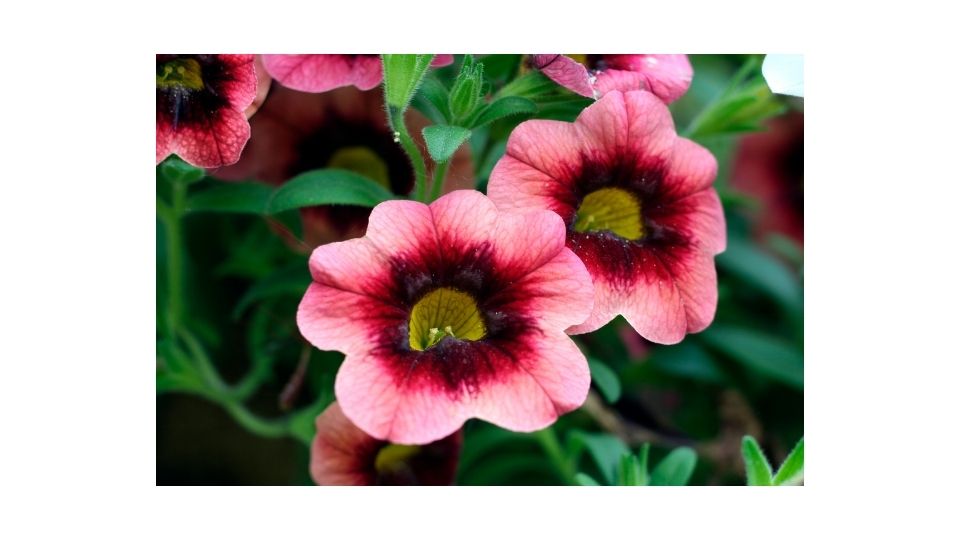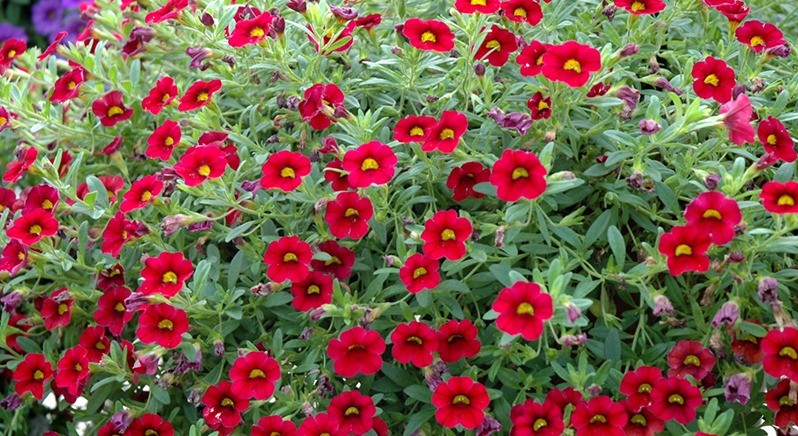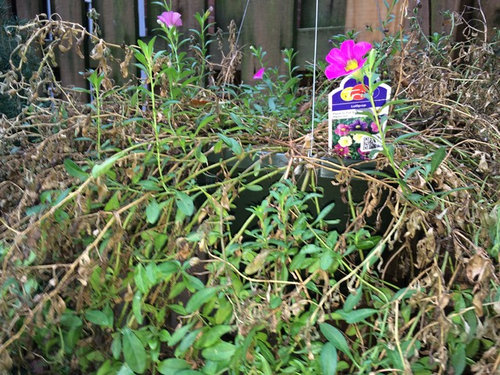A blooming plant called calibrachoa, commonly referred to as “Million bells,” is a perennial in mild regions but is classed as an annual in cold climates that encounter frost since it is not cold tolerant and dies back in the winter.
The most frequent cause of a dying calibrachoa is root rot brought on by too moist soil. Because calibrachoa like a wet and dry cycle of watering, its leaves can turn brown and droop and appear to be dying if the soil is continually damp due to poor drainage or overwatering.
Calibrachoa that has ceased growing or blooming and has yellowing leaves is in need of more fertilizer due to nutritional deficiency.
It’s critical to achieve the proper hydration balance in order to prevent root rot or dryness and prevent calibrachoa from dying.
Continue reading to discover how to save your calibrachoa so that it survives and blooms, as well as the finest practices for caring for them.
Table of Contents
Calibrachoa Dying of Root Rot (Calibrachoa Leaves Turning Brown)
The main cause of your Calibrachao’s death is usually too much moisture around the roots.
Native to South America and Mexico, calibrachoa flourish in open spaces, well-draining soil, and direct sunlight.
The circumstances for fungal diseases like root rot, which thrive in excessively moist soil that doesn’t drain well, are promoted if the soil around the roots is kept damp or muddy.
Root rot in a calibrachoa manifests as browning of the foliage and blooms, along with a drooping aspect.
The best way to water calibrachoa is to wet it deeply once a week and then let the soil somewhat (but not fully) dry out, preventing the roots from being sitting in permanently soggy soil.
This method of watering mimics the natural surroundings of calibrachoas.
Your calibrachoa’s surrounding soil may be overly soggy due to:
- putting trays under pots or other containers. However, if you put a saucer or drip tray under the pot, this prevents excess water from evaporating after watering or rainfall and causes the soil to become saturated, which is the cause of root rot. Calibrachoa grows exceptionally well in pots and containers.
- containers and pots without base drainage holes. Calibrachoa must have sufficient soil drainage in order to survive. If your pot or container is only cosmetic, it might not have have drainage holes in the bottom, preventing the buildup of water from evaporating and causing root rot, which causes the plant to become brown and wither.
- Calibrachoa in hanging baskets is perishing. Calibrachoa is a wonderful hanging basket plant since it can withstand the soil drying out in between waterings. However, occasionally, the soil in certain hanging baskets is lined with plastic sheeting or another material that can absorb too much water, causing the soil to get soggy and the calibrachoa to wilt, turn brown, and eventually die back from root rot.
- Overwatering has caused Calibrachoa to die. This is far too frequently for the calibrachoa to grow and bloom if you are watering it every day. Reduce watering to once per week (or two or three times per week for hanging baskets during a heatwave or drought) to mimic the average moisture levels of the calibrachoa’s native environment.
It is exceedingly difficult to salvage a calibrachoa with extensive root rot, thus prevention is preferable to treatment.
However, if it is water stressed, it may just show symptoms of stress, such as a drooping appearance, and it can recover if you improve the drainage and water it less frequently.
A calibrachoa plant needs to be revived in order to:
- In order to prevent the roots of the calibrachoa from being sitting in soggy soil, remove any drip trays or saucers from beneath pots and let excess water to evaporate.
- Try to remove the plastic membrane in the bottom of your hanging basket if your calibrachoa is there because it can be holding too much moisture.
- Avoid watering the calibrachoa for at least a week and protect it from rain.
- Do not fertilize the calibrachoa, and keep it in full light. With a clean pair of pruners, remove any foliage that is brown or yellow. After each cut, disinfect the blades with a cloth dipped in alcohol to prevent the transmission of any fungal spores to otherwise healthy plant tissue.
- Always plant calibrachoa in multipurpose compost as it has a structure that allows excess water to drain away from the roots to avoid the soil from becoming saturated while still retaining enough moisture for the calibrachoa to grow.
- In order to replicate the soil conditions desired by calibrachoa, always add compost to the planting area before planting. Clay soils should never be used to plant calibrachoa because they retain too much moisture, which leads to root rot and eventually the death of the plant. Plant calibrachoa in pots rather than the ground if your garden contains clay soil or bog sections since it is much simpler to create good drainage in pots and containers than in garden soil.
The risk of root rot is much reduced if you use the finest care techniques and maintain the proper balance of watering so that the soil has a chance to dry out. If your calibrachoa is water stressed, it should begin to recover after a week if you do this.
It’s crucial to stress that calibrachoa that has been submerged in water for a long period frequently dies.
Calibrachoa Dying Due to Under Watering (Wilting Foliage and Flowers)
Calibrachoa needs a balance of soil moisture, and the easiest way to achieve this is to grow the plant in good compost in pots, containers, and hanging baskets, and to water it once a week with a good soak.
However, the calibrachoa’s water needs may rise if there is a prolonged heat wave, wind, dry weather, or too sandy (or stony) soil.
Calibrachoa in hanging baskets are more susceptible to drought since they are exposed to the wind more and have less soil capacity than plants in pots and containers.
Remember that potting soil might bake hard if your pot or container has totally dried out, causing water to flow off the surface rather than sink into the soil.
In order to prevent water from running off the surface of the soil and away from the roots of your calibrachoa, make sure you water the soil around it carefully.
Numerous variables, including rainfall, temperature, and humidity, affect the frequency of watering, however in hotter areas or during a heat wave, it is best practice to water calibrachoa once every three to four days to achieve the ideal moisture balance.
If you believe that a drought is to blame for your calibrachoa’s demise, test the soil with your finger, keep an eye on the moisture level throughout the week, and water the plant as soon as it starts to feel a little dry.
In order for the calibrachoa to recuperate, you can use this to determine how regularly to water the pot or basket, precisely for your environment.
Once you find the ideal watering frequency for your climate, a dying calibrachoa with drooping leaves should be able to recover from drought within a week.
Calibraocha Leaves are Turning Yellow
If the leaves on your calibrachoa are turning yellow, there aren’t enough nutrients in the soil.
Because of its rapid growth, calibrachoa needs fertilizer to supply it with extra nutrients so that it can develop, flower, and keep its leaves from becoming yellow.
This is a typical issue for calibrachoa plants growing in small pots, containers, and hanging baskets because roots in small pots have less access to soil nutrients.
How to Revive Calibrachoa with Yellow Leaves
It’s crucial to fertilize your calibrachoa pots with a half strength all-purpose fertilizer if the leaves are yellowing in order to rejuvenate the plant.
To prevent issues with too much fertilizer, which can burn the roots of your plants, I prefer to use an all-purpose fertilizer like miracle-gro for calibrachoa grown in pots. It has all the nutrients that calibrachoa needs at the proper concentration.
Use a liquid fertilizer once every 2-4 weeks to keep your calibrachoa in top shape for optimum flowering and to prevent yellowing leaves.
Your calibrachoa should develop faster and get over its yellow color in the following two weeks if a nutrient deficiency is the issue.
Calibrachoa Requires Full Sun
Your calibrachoa needs more sun if it has weak, wiry growth, few flowers, and a sickly appearance.
In their original South American setting, calibrachoa are evolved to growing in wide spaces in warm temperatures and places with at least six hours of sun.
It’s crucial to place your calibrachoa in your garden’s most sunny region to guarantee that it’s healthy and has the best possible flower display.
More sun exposure also increases evaporation, which lowers the danger of root rot. It also keeps the plant healthy and disease-resistant.
To aid in the recovery of calibrachoa, relocate pots and containers to a spot that receives direct sunlight and place hanging baskets there.
Calibrachoa Dying in Cold Weather
Because they die back in the winter and frequently develop black foliage, calibrachoa is frequently thought of as an annual flowering plant for hanging baskets and pots in cool locations that see frost in the winter.
The only way to protect calibrachoa in cold climates is to grow them in pots, move them to a heated greenhouse for the winter, and then put them back outside after the risk of frost has passed.
The cold-sensitive calibrachoa can benefit from the protection of horticultural fleece against chilly nights and sporadic frost.
Key Takeaways:
- Typically, fungal infections like root rot brought on by an abundance of moisture around the roots are what cause calibrachoa to die. Calibrachoa needs the soil to dry out between waterings; hence, if the plant is overwatered or in soggy soil, the leaves will become brown and wilt, which will cause the calibrachoa plants to die.
- Nutrient deficiencies are the cause of yellow calibrachoa leaves. Due to its rapid development, calibrachoa is a heavy feeder and needs fertilizer once every four weeks to prevent yellow foliage and encourage flowering.
- Drought can affect Calibrachoa, causing the leaves to wilt. In warmer weather, calibrachoa in hanging baskets and pots is susceptible to drying out too rapidly. In hot and dry weather, increase watering to once every three or four days.
- South American native calibrachoa needs full sun and soil that drains well. Too much shadow frequently causes Calibrachoa to grow slowly and produce few blooms. For the calibrachoa to heal and produce flowers, make sure it is situated in full sunlight.
FAQ
How often do you water calibrachoa?
The best way to water calibrachoa is to wet it deeply once a week and then let the soil somewhat (but not fully) dry out, preventing the roots from being sitting in permanently soggy soil. This method of watering mimics the natural surroundings of calibrachoas.
How do you fix root rot in calibrachoa?
Get rid of sick plants, plant detritus, and contaminated soil. Apply Cleary’s 3336, Fungo Flo, Contrast, Medallion, or Terraguard to the soil. Fungicide must come in contact with the stems in order to effectively control stem rot.
Will Calibrachoa come back?
Do they return each year? Depending on where you reside. Since calibrachoa is a perennial in USDA hardiness zones 9 to 11, it will flourish all winter long. Calachoa functions as an annual for those of us who live in colder climates.
How do you treat Calibrachoa?
Drench transplants immediately after transplanting.



